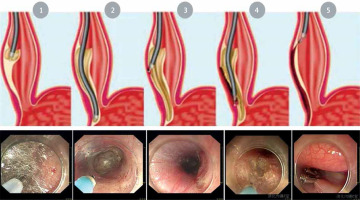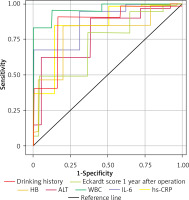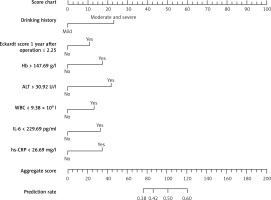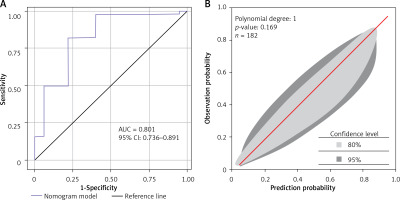Introduction
Achalasia (AC), an esophageal motility disorder, mainly affects young and middle-aged people, clinically manifested as dysphagia, gastric juice reflux, vomiting, and weight loss [1]. The disease is caused by the absence of esophageal peristalsis and impairment of relaxation function of the lower esophageal sphincter [2–4], seriously impacting the patients’ quality of life. According to current research, immunity, heredity, infection and certain inflammatory factors are associated with its initiation. However, there is a lack of specific treatment measures for AC. Drug therapies for AC mainly include calcium antagonists and nitrates, which have no obvious efficacy and do not change the course of disease, so they are rarely adopted at present. Nevertheless, in clinical surgery, peroral endoscopic myotomy (POEM), a new minimally invasive technique for submucosal myotomy through tunnel endoscopy, is feasible [5–8]. Since the application of POEM in clinical treatment of AC was reported in 2010, the postoperative symptom remission rate of patients has been high, so it has been in the spotlight [9, 10].
Aim
The therapeutic effect of POEM in the treatment of AC has been recognized by the medical profession. However, the factors associated with the efficacy have not been reported so far. In this study, therefore, the effective factors of POEM in the treatment of AC were investigated, so as to find out the effective evidence of the treatment outcome.
Material and methods
Subjects
A total of 182 AC patients treated between August 2019 and September 2020 were enrolled to receive POEM. According to the treatment outcomes, the patients were divided into an effective group (n = 143) and an ineffective group (n = 39). In the effective group, there were 79 males and 64 females, with an age of 42.36 ±11.57 years. Their course of disease was 0.26–416 months, and their preoperative Eckardt score was 5.21 ±1.31 points. In the ineffective group, there were 25 males and 14 females, with an age of 43.04 ±10.91 years, a course of disease of 0.19–420 months, and a preoperative Eckardt score of 5.18 ±1.06 points. No significant differences were found in the general data of patients between the two groups (p < 0.05).
Effectiveness evaluation was conducted during follow-up at 1 day after the operation using the Eckardt score, which consisted of dysphagia, reflux, frequency of chest pain, and weight loss. The Eckardt score at 1 day after the operation ≤ 3 points or decreased by > 3 points compared with that before the operation indicated effectiveness; otherwise, symptom recurrence was considered.
Related criteria
The inclusion criteria involved: (1) patients with clinical symptoms and recurrent AC diagnosed by esophageal manometry, barium radiography of upper digestive tract or gastroscopy, (2) those ≥ 18 years old, and (3) those who received POEM in our hospital.
The exclusion criteria were as follows: (1) patients with incomplete clinical data, (2) those with a malignant tumor, or (3) those who could not undergo POEM due to other diseases. This study was approved by the Ethics Committee, and all the patients and their families signed the informed consent.
Observation indices
The clinical data of patients were recorded, including drinking history, Eckardt score, gender, age, course of disease, smoking history, incision length, operation time, fasting time, hospital stay, medical expenses, and histories of diabetes mellitus, hypertension and drug allergy. In addition, the biochemical indices of the patients were detected, including hemoglobin (Hb), alanine aminotransferase (ALT), white blood cell count (WBC), interleukin-6 (IL-6), hypersensitive C-reactive protein (hs-CRP), red blood cell count (RBC), triglyceride (TG), low-density lipoprotein (LDL), high-density lipoprotein (HDL), and mean platelet volume (MPV).
Methods
Before the operation, all patients were given general anesthesia via endotracheal intubation. During the operation, a transparent cap was placed at the front end of the endoscope, and indigo carmine epinephrine saline solution was injected under the mucosa of the left wall at 8–10 cm above the cardia. After the local mucosa was fully lifted, the mucous layer was cut open with a knife (KD-620LR) to form a transverse incision, which was then separated by the knife (KD-620LR) to form a tunnel extending to 2–3 cm below the cardia. Thereafter, the esophageal circular muscle and part of the longitudinal muscle along the left wall of the esophagus in the tunnel was cut open with the knife (KD-620LR), and the fibrous membrane was kept intact. After the bleeding in the tunnel was addressed and rinsed, the entrance of the tunnel was clamped longitudinally with a metal titanium clamp. After no active bleeding was assured, the endoscope was withdrawn, followed by placement of the gastric tube [11–14] (Photo 1).
Statistical analysis
SPSS 22.0 software was utilized for statistical analysis. The measurement data were represented as x ± SD and compared by t-test. The numerical data were expressed as rate and compared by χ2 test. A multivariate logistic regression model was employed for analysis. P < 0.05 indicated that a difference was statistically significant.
Results
Therapeutic effects of POEM on AC
No significant difference was found in the preoperative Eckardt score between the two groups (p > 0.05). There were differences in the Eckardt score and incidence of reflux at 1 year after the operation, and the effective rate at 6 months and 1 year after the operation (p < 0.05). Moreover, the Eckardt score and incidence of reflux at 1 year after the operation were lower in the effective group than those in the ineffective group, and the effective rate at 6 months and 1 year after the operation was higher in the effective group than that in the ineffective group (Table I).
Table I
Therapeutic effect of POEM on AC
Univariate analysis results of therapeutic effects of POEM on AC
Significant differences were observed in drinking history, Eckardt score at 1 year after the operation, Hb, ALT, WBC, IL-6 and hs-CRP between the two groups (p < 0.05). Also, the Eckardt score at 1 year after the operation, WBC, IL-6 and hs-CRP were lower, while the levels of Hb and ALT were higher in the effective group than those in the ineffective group. Gender, age, course of disease, history of smoking, incision length, operation time, fasting time, hospital stay, medical expenses, histories of diabetes mellitus, hypertension and drug allergy, RBC, TG, LDL, HDL and MPV displayed no significant differences between the two groups (p > 0.05) (Table II).
Table II
Univariate analysis results of therapeutic effects of POEM on AC
[i] AC – achalasia, ALT – alanine aminotransferase, Hb – hemoglobin, HDL – high-density lipoprotein, hs-CRP – hypersensitive C-reactive protein, IL-6 – interleukin-6, LDL – low-density lipoprotein, MPV – mean platelet volume, POEM – peroral endoscopic myotomy, RBC – red blood cell count, TG – triglyceride, WBC – white blood cell count.
Results of multivariate logistic regression analysis
The therapeutic effect of POEM on AC was taken as the dependent variable, and the factors with statistical significance (p < 0.05, screened out in univariate analysis) were taken as the independent variables (Table III). Multivariate logistic analysis revealed that drinking history, Eckardt score at 1 year after the operation, Hb, ALT, WBC, IL-6, and hs-CRP were independent factors affecting the therapeutic effect of POEM on AC (Table IV).
Table III
Variable assignment
Table IV
Results of multivariate logistic regression analysis
Receiver operating characteristic (ROC) curves of therapeutic effects of POEM on AC
The ROC curve of therapeutic effect of POEM on AC was plotted, and the areas under the curve (AUCs) of drinking history, Eckardt score at 1 year after the operation, Hb, ALT, WBC, IL-6, and hs-CRP were 0.871, 0.727, 0.722, 0.837, 0.915, 0.864, and 0.855 respectively. Their sensitivity was 79.1%, 78.3%, 78.8%, 81.7%, 80.8%, 78.9%, and 81.3%, respectively, and their specificity was 80.9%, 84.2%, 79.2%, 86.6%, 82.2%, 82.4%, and 81.8%, respectively (Figure 1, Table V).
Model establishment
A nomogram model for predicting the therapeutic effect of POEM on AC was constructed based on the results of multivariate regression analysis, which demonstrated that drinking history and ALT had the greatest influence on AC patients, followed by hs-CRP, Hb, IL-6, Eckardt score at 1 year after the operation, and WBC. After the clinicopathological information of each AC patient was imported into the nomogram model, the corresponding scores were obtained from the score scale. The scores of drinking history, Eckardt at 1 year after the operation, Hb, ALT, WBC, IL-6, and hs-CRP were 22, 13, 17, 22, 13, 16, and 17 points respectively, and the value corresponding to the total score (120 points) was 60.00%, which was the effective rate of POEM on AC (Figure 2).
Calibration and discrimination of model
The discrimination and calibration of the therapeutic effect of POEM on AC were evaluated. AUC for discrimination evaluation was 0.801 (95% CI: 0.736–0.891, p < 0.001), so the discrimination was good (Figure 3 A). The calibration curve of the prediction model had a clear and obvious band, with a certain discrimination (p = 0.169). It could be seen that the prediction probability of the model was close to the actual observation probability, showing a strong consistency (Figure 3 B).
Discussion
At present, there is no gender difference in the incidence of AC, and it frequently occurs at the age of 20–40 years. Due to unclarified etiology and mechanism, the therapeutic effect varies in patients. It has been proposed that [15, 16] mental factors, viral infections, autoimmunity, genetic factors and so on can lead to different therapeutic effects, but no specific influencing factors have been put forward. Although the etiology of AC has not been clarified yet, many investigations have demonstrated that the pathogenesis of AC is probably that genetically susceptible individuals suffered inflammation and a delayed immune response due to changes in environmental factors such as viral infection. For this reason, many inflammatory and immune indicators may affect the therapeutic effect. On the other hand, AC is treated by many means, and POEM is a common surgical method for the treatment of AC, despite its incompletely clarified therapeutic mechanism [17–20]. Some researchers believe that its therapeutic mechanism may have an association with the degree of sufficient myotomy and the healing degree of tissue fibrosis [21]. According to the study of Jacobson et al. [10], course of disease was an independent factor influencing the therapeutic effect of AC after POEM. Since the use of POEM in clinical treatment of AC in 2010, the postoperative symptom remission rate of patients has remained high. As a result, POEM has been in the spotlight.
In the present study, the effective factors of POEM in treating AC were investigated, and it was found that drinking history, Eckardt score at 1 year after the operation, Hb, ALT, WBC, IL-6, and hs-CRP were independent factors affecting the therapeutic effect of POEM on AC. Patients with a history of drinking may suffer more evident neuromuscular dysfunction in the esophagus and cardia due to stimulation by ethanol. Moreover, ethanol entering the human body will severely disturb normal gastrointestinal function of the patients, causing more serious difficulty in eating. Eckardt score at 1 year after the operation can reflect the recovery of patients on the aspects of dysphagia, reflux, frequency of chest pain, and weight loss. If the score slightly declines compared with that before the operation, the recovery mechanism is destroyed, and the therapeutic effect may be limited. Hb, an item in blood routine tests, can be transported to various tissues of the whole body after combination with oxygen in the lungs. If the content of Hb is below a certain value, the oxygen carriage capability will be weakened, and normal regulation of the neuromuscular function of the esophagus and cardia will fail, so the therapeutic effect will be unsatisfactory. ALT, usually a vital index reflecting the liver function, showed a certain value for the evaluation of the therapeutic effect of AC patients in this study, which may be caused by the difference in incision means. Due to the impact on the digestive function of patients, the metabolic level was repressed, leading to decreased enzyme activity. In addition, WBC, IL-6 and hs-CRP are all associated with inflammatory factors. According to a study [22], mechanical operations in surgery may result in some inflammatory cytokines in patients, aggravating nerve injury and impeding nerve repair. Meanwhile, it was found in this study that there were differences in the Eckardt score and incidence of reflux at 1 year after the operation, and the effective rate at 6 months and 1 year after the operation (p < 0.05). Moreover, the Eckardt score and incidence of reflux at 1 year after the operation were lower in the effective group than those in the ineffective group, and the effective rate at 6 months and 1 year after the operation was higher in the effective group than that in the ineffective group. The ROC curve of the therapeutic effect of POEM on AC indicated that the AUCs of drinking history, Eckardt score at 1 year after the operation, Hb, ALT, WBC, IL-6 and hs-CRP were 0.871, 0.727, 0.722, 0.837, 0.915, 0.864, and 0.855, respectively, and they had high fitting degrees, so they were influencing factors for the real therapeutic effect.
In addition, a nomogram model was constructed in this study to predict the therapeutic effect of POEM on AC. The discrimination and calibration of the model were assessed, and it was found that the AUC of discrimination evaluation was 0.801 (95% CI: 0.736–0.891, p < 0.001), so the discrimination was good. The calibration curve of the prediction model had a clear and obvious band, with a certain discrimination (p = 0.169). It could be seen that the prediction probability of the model was close to the actual probability observed, showing a strong consistency. There were also some limitations in this study requiring attention and improvement in future research: (1) This is a single-center study with a relatively small sample size, so it is hoped that multi-center studies with a larger sample size can be performed later to confirm the reliability of the results of this study. (2) It is difficult to explain the time sequence and causality between influencing factors and malignant changes in this cross-sectional study, so the results require verification by cohort studies.












